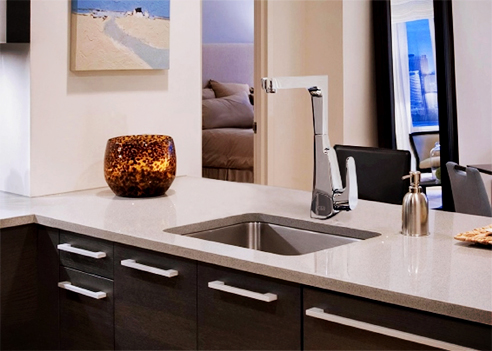Automated Taps for Convenience & Hygiene from TILO Tapware

Whether you own a home, restaurant or retail store; functionality and hygiene are a necessity. The common tap or 'faucet' provides a place for you and your guests to clean their hands and complete other kitchen or bathroom duties. The big decision when outfitting these premises is whether to install manually operated taps or automated taps. Manually operated taps generally come at a lower initial cost and are reasonably reliable due to their simplicity and minimal number of working parts as opposed to say infrared sensor taps which require a power source, sensor and a solenoid operated valve but there may be some other deciding factors one should consider other than economics. For instance convenience, ergonomics and hygiene being the main key factors.
Differences
Manually operated taps as the name suggest are just that. Manually operated and determined by the user for the adjustment of the water temperature, flow volume and length of time the user requires by the manipulation of a lever, knob or handle. With automated taps the temperature and volume of flow is pre-set so this eliminates the operator's control over this. Electronic sensor taps use an infrared sensor (transmitter) that sends an infrared signal and a receiver to detect the deflection when the users hand passes in front of the transmitted signal. The receiver sends the signal transmitting an electrical pulse that triggers a solenoid that opens the valve for the water to flow through. There is usually a timer that allows the water to run for a specified period before shutting off.
The obvious differences between manual and automated taps from a hygiene point of view is that auto' taps do not require the user to actually contact the tap but by simply placing ones hands within the sensors range triggers the solenoid actuated valve. This sensor is usually located under the spout area. The distance is adjusted close enough so that the sensor is not accidentally triggered by other reflective objects or passing patrons. With manual operated faucets the user has to physically touch the lever, handles or knobs in order to operate it.

Other knee or foot operated taps may also be a serious consideration as these being essentially a mechanical device will deliver some of the same control benefits of manual operated taps but with the hygienic benefits of automated taps and because they eliminate the need of a power supply, and the costly maintenance required for the sometimes fickle electronic sensors and solenoids, they may well be the best solution for your situation.
What about Hygiene Benefits?
It is because automatic taps can be turned on without physical touch, that they are considered a more hygienic choice compared to a manual faucets. The idea is by eliminating the need of physical touch that the possibility of germs and bacteria being transferred from one person to another will be reduced. However, extended lever handles are commonly still used in hospitals and surgery theatres giving surgeons the ability to fully control the washing of hands by using their elbows to manipulate and control the level of water.
An independent study however by a number of specialists shows that automatic faucets may actually harbor more bugs than manually operated taps. According to researchers at Johns Hopkins Hospital, about 50% of the water samples from the automatic faucets tested positive for legionella and other bacteria. In contrast, a mere 15% of manual faucets harbored bacteria. But according to Dr. Emily Sydnor, an infectious diseases specialist at John Hopkins, the bacteria that was found poses no health risks for most people. Quite frankly, the water samples were taken throughout the hospital (as well as patient rooms), and there were no reports of patients getting infected from the water. And when compared to manual faucets, the automatic device is still a better option for reducing communicable bacteria.
Water and Money Saving
Compared to manual faucets it could be said that automatic faucets are more economical to run for the long term despite their higher initial cost but this would however only be true if users of manually operated faucets forget to turn off taps or have a habit of leaving the water running while brushing their teeth or shaving. Certainly this would probably be the case in busy public facilities. Automatic taps this scenario would more likely than not be a great benefit to the environment and water conservation due to the taps timed mechanism but on the other hand (no pun intended) manual operated faucets could save user money as the amount of flow and length of time could be greatly reduced for conscientious users.


|







 Curved Spout for Spas by Tilo Tapware
Curved Spout for Spas by Tilo Tapware Free Standing Bath Tubs for Homes by
Free Standing Bath Tubs for Homes by Brushed Gold Shower Combo by Tilo
Brushed Gold Shower Combo by Tilo Lead Free Sink Mixer for Kitchens by
Lead Free Sink Mixer for Kitchens by Space Saving Bathroom Solutions by Tilo
Space Saving Bathroom Solutions by Tilo Space Saving Sinks for Bathrooms by Tilo
Space Saving Sinks for Bathrooms by Tilo Stainless Steel Tapware Supplier by Tilo
Stainless Steel Tapware Supplier by Tilo Design Tips for Laundry Rooms by Tilo
Design Tips for Laundry Rooms by Tilo Handheld Bidet Wash by Tilo Tapware
Handheld Bidet Wash by Tilo Tapware Plug and Waste for Sinks by Tilo Tapware
Plug and Waste for Sinks by Tilo Tapware Two Tone Kitchen Faucet by Tilo Tapware
Two Tone Kitchen Faucet by Tilo Tapware Bottle Traps for Basins by Tilo Tapware
Bottle Traps for Basins by Tilo Tapware Two Person Spa Bath by Tilo Tapware
Two Person Spa Bath by Tilo Tapware Matt Black Basins by Tilo Tapware
Matt Black Basins by Tilo Tapware Sink with Kitchen Accessories by Tilo
Sink with Kitchen Accessories by Tilo Inset Baths by Tilo Tapware
Inset Baths by Tilo Tapware Swivel Bath Spout by Tilo Tapware
Swivel Bath Spout by Tilo Tapware Ergonomic Solid Brass Basin Mixers from
Ergonomic Solid Brass Basin Mixers from Black Sink for Kitchens from Tilo
Black Sink for Kitchens from Tilo Freestanding Acrylic Bathtubs from Tilo
Freestanding Acrylic Bathtubs from Tilo
